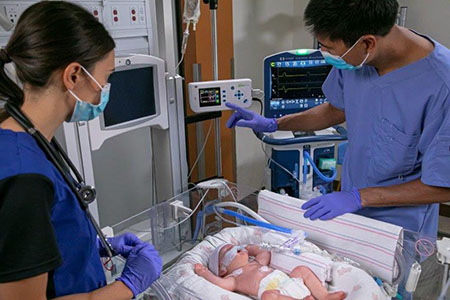Big Innovations for Tiny Patients
The SonarMed™ airway monitoring system helps address a life-threatening risk to newborns treated with a mechanical ventilator: dislodged and occluded breathing tubes.
Bringing advanced technology to our smallest patients isn’t easy.
Sick newborns are fragile, unable to communicate, and require constant monitoring. And their dedicated caregivers want to be certain that any novel technology benefits their patients without disruption.
“These are some of the most vulnerable patients,” said Camille Johnson, Senior Marketing Manager in Medtronic’s Respiratory Interventions Operating Unit. “You absolutely have to get therapies for them right.”

Medtronic has a long-standing commitment to serving these vulnerable patients, and meeting the needs of clinicians who care for them. And this commitment is expanding.
In recent months, the company’s Respiratory Interventions (RI) Operating Unit launched two leading-edge technologies that will bring meaningful innovation to Neonatal Intensive Care Units (NICU) and Pediatric Intensive Care Units (PICU).
The newest first-of-its-kind product is the SonarMed™ airway monitoring system, which helps address a challenge facing newborns treated with a mechanical ventilator: dislodged and occluded breathing tubes.
Patients on ventilators can have breathing tubes placed in their airways, and those tubes can move as these are babies moved. If a breathing tube shifts too much or dislodges, the patient may lose their breathing support and not get enough oxygen. This leaves clinicians scrambling to find a solution in a matter of seconds before oxygen levels become dangerously low, placing the baby at risk of organ damage.
The Medtronic SonarMed system can help by using real-time, continuous acoustic technology to verify the position of the tube, and confirm it is not obstructed. It also delivers timely alerts. Combined, this gives clinicians data to make more informed — and potentially life-saving — decisions.
"The SonarMed airway monitoring device has revolutionized the way we care for our littlest patients,” said Jamie W. Powers, M.D., MBA, neonatologist at Huntington Hospital in Pasadena, California. “There is no other device in the world that can tell you where the endotracheal tube is located within the airway continuously in real-time, and whether the tube is obstructed or even partially occluded."
Meeting challenges under extraordinary circumstances
In addition to introducing new devices, Medtronic is also bringing innovative ventilation software to the NICU.
For example, the RI team recently launched the NIV+ software for the company’s most advanced Puritan Bennett™ ventilator. For the first time, this technology allows clinicians to monitor ventilating pressures applied via noninvasive interfaces, giving them new data to make more informed decisions about ventilation management.
Of course, these innovations might not have reached patients at all if not for dedicated Medtronic employees working under extraordinary circumstances during the pandemic.
That was especially true for the NIV+ software. The technology needed to undergo critical testing amid the pandemic — a time when our RI teams were already racing to serve the growing number of COVID-19 patients who needed ventilators.
To avoid significant delays, the RI team raced to find a new site for an evaluation that was the last step in the process for bringing this innovative software to market.
Medtronic teams also created remote training programs for both the SonarMed airway monitoring system and NIV+ software, and acted quickly to bring the technologies to market.
Combined, these efforts reflect the company’s commitment to making sure some of the world’s most fragile patients get the best care.
“With all of the challenges in the past year, this work could easily have been pushed back,” said Abby Scaggs, Global Product Manager for SonarMed. “But we know how important it is to fulfill our Mission – and serve these patients.”
Envisioning the Future of Healthcare
Explore Healthcare Insights
Legal disclaimers:
For SonarMed:
The SonarMed™ airway monitoring system should not be used as the sole basis for diagnosis or therapy and is intended only as an adjunct in patient assessment.
For NIV+
Warning:
The ventilator offers a variety of breath delivery options. Throughout the patient's treatment, the clinician should carefully select the ventilation mode and settings to use for that patient based on clinical judgment, the condition and needs of the patient, and the benefits, limitations and characteristics of the breath delivery options. As the patient's condition changes over time, periodically assess the chosen modes and settings to determine whether or not those are best for the patient's current needs.
Warning:
Do not attempt to calibrate the NIV interface with a patient connected. Doing so may result in the patient not receiving clinician-set ventilation.
Warning:
To avoid incorrect assessment of the resistance of the interface during calibration, verify that the interface is unobstructed, unkinked, and in a position that most closely mimics how it will be positioned on a patient. Keep the entire setup still until the calibration is complete.
